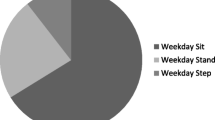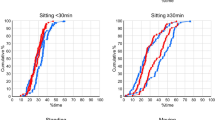Abstract
This study aimed to assess sitting time and number of steps taken each day, and the relationships between these variables, in a sample of working Australian adults. Workers (N = 185) wore a pedometer for 7 days and recorded the number of steps taken and time spent sitting each day. Average time spent sitting on weekdays was 9.4 (SD = 2.40) hr, with about half spent sitting at work. Despite this, the average steps taken each day (M = 8,873, SD = 2,757) was higher on weekdays than on weekend days. There was a clear inverse relationship between sitting time at work and number of steps taken on weekdays, r = -.34, p < .001); those in the highest tertile for sitting time reported about 3,000 fewer daily steps. Workers in managerial and professional occupations reported more time sitting at work (M = 6.2 hr per day) and lower weekday step counts (M = 7,883, N = 43) than technical (M = 3.3 hr sitting at work and 10,731 weekday steps, N = 33) and blue collar workers (M = 1.6 hours sitting and 11,784 steps, N = 11). The findings suggest those whose daily work involves long hours of sitting should be the focus of efforts to promote physical activity both within and outside the workplace.
Similar content being viewed by others
References
Armstrong, T., Bauman, A., & Davies, J. (2000). Physical activity patterns of Australian adults. Results of the 1999 national physical activity survey. Canberra: Australian Institute of Health and Welfare.
Brown, W., (2003). [Self-reported sitting time of middle-aged Australian women]. Unpublished raw data from the Australian Longitudinal Study on Women’s Health.
Brown, W., Ringuet, C., & Trost, S. (2002). How active are adult women? Health Promotion Journal of Australia, 13, 23–28.
Brown, W. J., Miller, Y. D., & Miller R. (2003). Sitting time and work patterns as indicators of overweight and obesity in Australian adults. International Journal of Obesity, 27, 1340–1346.
Bull, F., Milligan, R., Rosenberg, M., & MacGowan, H. (2000). Physical activity levels of Western Australian adults 1999. Published by the Health Department of Western Australia and the Sport and Recreation Way2Go. Perth: Western Australian Government.
Craig, C. L., Marshall, A. L., Sjostrom, M., Bauman, A. E., Booth, M. L., Ainsworth, B. E., et al. (2003). International Physical Activity Questionnaire: 12-country reliability and validity. Medicine and Science in Sports and Exercise, 35, 1381–1395.
Hatano, Y. (1993). Use of pedometer for promoting daily walking exercise. International Council of Health, Physical Education and Recreation, Summer, 4–8.
Hu, F. B., Li, T. Y., Colditz, G. A., Willet, W. C., & Manson, J. E. (2003). Television watching and other sedentary behaviours in relation to risk of obesity and Type 2 diabetes mellitus in women. Journal of the American Medical Association, 289, 1785–1791.
Ichihara, Y., Hattori, R., Ano, T., Okuma, K., Yokoi, M., Mizuno, Y., et al. (1996). Oxygen up take and it srelation to physicalactivity and other coronary risk factors in asymptomatic middle-aged Japanese. Journal of Cardiopulmonary Rehabilitation, 16, 378–385.
McGraw, K. O., & Wong, S. P. (1996). Forminginferencesabout some intraclass correlation coefficients. Psychological Methods, 1, 30–46.
Queensland Health and Australian Institute of Health and Welfare. (2003). Physical activity patterns of Queensland adults. Brisbane, Australia: Queensland Health.
Salmon, J., Bauman, A., Crawford, D., Timperio, A., & Owen, N. (2000). The association between television viewing and overweight among Australian adults participating in varying levels of leisure-time physical activity. International Journal of Obesity, 24, 600–606.
Schneider P. L., Crouter S. E., Lukajiz O., & Bassett D. R. (2003). Accuracy and reliability of 10 pedometers for measuring steps over a 400-m walk. Medicine and Science in Exercise in Sports & Exercise, 35, 1779–1784.
Sequeira, M. M., Rickenbach, M., Wietlisbach, V., Tullen, B., & Schutz, Y. (1995). Physical activity assessment using a pedometer and its comparison with a questionnaire in a large population survey. American Journal of Epidemiology, 142, 989–999.
SPSS for Windows. (2002). Version 11.0 standard. Chicago: SPSS Inc.
Tudor-Locke, C. E., Ainsworth, B. E., Whitt, M. C., Thompson, R. W., Addy, C. L., & Jones, D. A. (2001). The relationship between pedometer-determined ambulatory activity and body composition. International Journal of Obesity, 25, 1571–1578.
Tudor-Locke, C. E., & Myers, A. M. (2001). Methodological considerations for researchers and practitioners using pedometers to measure physical (ambulatory) activity. Research Quarterly for Exercise and Sport, 72, 1–12.
United States Department of Health & Human Services. (1986). Physical activity and health: a report of the Surgeon General. Atlanta, GA: U. S. Department of Health and Human Services, Centers for Disease Control and Prevention, National Center for Chronic Disease Prevention and Health Promotion.
Welk, G. J., Differding, J. A., Thompson, R. W., Blair, S. N., Dziura, J., & Hart, P. (2000). The utility of the digi-walker step counter to assess daily physical activity patterns. Medicine and Science in Sports and Exercise, 32, S481-S488.
Wolf, A. M., Hunter, D. J., Colditz, G. A., Manson, J. E., Stampfer, M. J., Corsano, K. A., et al. (1994). Reproducibility and validity of a self-administered physical activity questionnaire. International Journal of Epidemiology, 23, 991–999.
Venn, A., Blizzard, L., Dwyer, T., Cochrane, J., & Hynes, K. (2002). The use of pedometers to measure physical activity in large population-based studies. Unpublished report. Tasmania: Menzies Centre for Population Health Research, University of Tasmania.
Author information
Authors and Affiliations
Rights and permissions
About this article
Cite this article
Miller, R., Brown, W. Steps and sitting in a working population. Int. J. Behav. Med. 11, 219–224 (2004). https://doi.org/10.1207/s15327558ijbm1104_5
Issue Date:
DOI: https://doi.org/10.1207/s15327558ijbm1104_5




